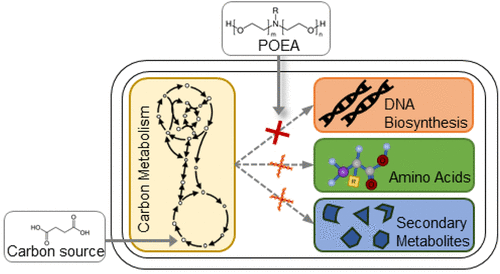当前位置:
X-MOL 学术
›
Environ. Sci. Technol. Lett.
›
论文详情
Our official English website, www.x-mol.net, welcomes your feedback! (Note: you will need to create a separate account there.)
Adverse Metabolic Outcomes in Soil Pseudomonas Species Exposed to Polyethoxylated Tallow Amine and Glyphosate
Environmental Science & Technology Letters ( IF 10.9 ) Pub Date : 2019-07-29 , DOI: 10.1021/acs.estlett.9b00363 Caroll M. Mendonca 1 , Michael L. Reed 1 , Matthew A. Kukurugya 1 , Ludmilla Aristilde 1, 2
Environmental Science & Technology Letters ( IF 10.9 ) Pub Date : 2019-07-29 , DOI: 10.1021/acs.estlett.9b00363 Caroll M. Mendonca 1 , Michael L. Reed 1 , Matthew A. Kukurugya 1 , Ludmilla Aristilde 1, 2
Affiliation

|
Polyethoxylated tallow amine (POEA) is a common surfactant used in glyphosate-based herbicide formulations to enhance the bioavailability of the active herbicide ingredient. Toxic effects of POEA exposure are well documented for aquatic organisms, but despite the widespread occurrence of POEA in soils, the potential effects on soil bacteria have not been investigated. Here we examined the growth and metabolic effects of POEA in three strains of plant-beneficial soil Pseudomonas species (Pseudomonas putida KT2440, P. putida S12, and P. protegens Pf-5) grown on succinate, a common root exudate. Compared to the rate of growth on only succinate, the addition of POEA resulted in up to 60% reduction in the biomass growth rate. In the presence of both POEA and glyphosate, the biomass growth rate either remained the same as during exposure to only POEA or decreased by only an additional 5–15%, thus indicating that growth inhibition was primarily caused by POEA. Metabolomics analysis of POEA-exposed cells identified, relative to control cells, disruption of metabolite levels in key biosynthetic pathways: accumulation of ribonucleotides and depletion of amino acids. Kinetic 13C flux experiments further revealed delayed de novo biosynthesis of pyrimidine ribonucleotides. Our findings thus highlight disconnects between carbon metabolism and biomass biosynthesis as potential adverse metabolic outcomes in POEA-exposed soil-beneficial bacteria.
中文翻译:

暴露于聚乙氧基牛脂胺和草甘膦的土壤假单胞菌物种的不利代谢结果
聚乙氧基牛脂胺(POEA)是基于草甘膦的除草剂配方中常用的表面活性剂,可增强活性除草剂成分的生物利用度。充分记录了POEA暴露对水生生物的毒性作用,但是尽管POEA在土壤中广泛存在,但尚未研究对土壤细菌的潜在作用。在这里,我们研究了三种植物有益土壤假单胞菌种(假单胞菌假单胞菌KT2440,恶臭假单胞菌S12和体育假单胞菌)中POEA的生长和代谢效应。Pf-5)在琥珀酸盐(一种常见的根系分泌物)上生长。与仅琥珀酸盐的生长速度相比,POEA的添加导致生物量生长速度降低多达60%。在同时存在POEA和草甘膦的情况下,生物量的增长率要么与仅暴露于POEA期间相同,要么仅降低了5–15%,因此表明生长抑制主要是由POEA引起的。相对于对照细胞,POEA暴露细胞的代谢组学分析确定了关键生物合成途径中代谢物水平的破坏:核糖核苷酸的积累和氨基酸的消耗。动力学13 C通量实验进一步揭示了从头开始的延迟嘧啶核糖核苷酸的生物合成。因此,我们的研究结果突出显示了碳代谢和生物量生物合成之间的脱节,这是暴露于POEA的土壤有益细菌中潜在的不利代谢结果的原因。
更新日期:2019-07-29
中文翻译:

暴露于聚乙氧基牛脂胺和草甘膦的土壤假单胞菌物种的不利代谢结果
聚乙氧基牛脂胺(POEA)是基于草甘膦的除草剂配方中常用的表面活性剂,可增强活性除草剂成分的生物利用度。充分记录了POEA暴露对水生生物的毒性作用,但是尽管POEA在土壤中广泛存在,但尚未研究对土壤细菌的潜在作用。在这里,我们研究了三种植物有益土壤假单胞菌种(假单胞菌假单胞菌KT2440,恶臭假单胞菌S12和体育假单胞菌)中POEA的生长和代谢效应。Pf-5)在琥珀酸盐(一种常见的根系分泌物)上生长。与仅琥珀酸盐的生长速度相比,POEA的添加导致生物量生长速度降低多达60%。在同时存在POEA和草甘膦的情况下,生物量的增长率要么与仅暴露于POEA期间相同,要么仅降低了5–15%,因此表明生长抑制主要是由POEA引起的。相对于对照细胞,POEA暴露细胞的代谢组学分析确定了关键生物合成途径中代谢物水平的破坏:核糖核苷酸的积累和氨基酸的消耗。动力学13 C通量实验进一步揭示了从头开始的延迟嘧啶核糖核苷酸的生物合成。因此,我们的研究结果突出显示了碳代谢和生物量生物合成之间的脱节,这是暴露于POEA的土壤有益细菌中潜在的不利代谢结果的原因。



























 京公网安备 11010802027423号
京公网安备 11010802027423号